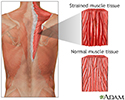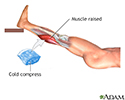Strains
Pulled muscle
A strain is when a muscle is stretched too much and tears. It is also called a pulled muscle. A strain is a painful injury. It can be caused by an accident, overusing a muscle, or using a muscle in the wrong way.
Causes
A strain may be caused by:
- Too much physical activity or effort
- Improperly warming up before a physical activity
- Poor flexibility
Symptoms
Symptoms of a strain can include:
- Pain and difficulty moving the injured muscle
- Discolored and bruised skin
- Swelling
First Aid
Take the following first aid steps to treat a strain:
- Apply ice right away to reduce swelling. Wrap the ice in cloth. Do not place ice directly on the skin. Apply ice for 10 to 15 minutes every 1 hour for the first day and every 3 to 4 hours after that.
- Use ice for the first 3 days. After 3 days, either heat or ice may be helpful if you still have pain.
- Rest the pulled muscle for at least a day. If possible, keep the pulled muscle raised above your heart.
- Try not to use a strained muscle while it is still painful. When the pain starts to go away, you can slowly increase activity by gently stretching the injured muscle.
When to Contact a Medical Professional
Call your local emergency number, such as 911, if:
- You are unable to move the muscle.
- The injury is bleeding.
Call your health care provider if the pain does not go away after several weeks.
Prevention
The following tips may help you reduce your risk of a strain:
- Warm-up properly before exercise and sports.
- Keep your muscles strong and flexible.
References
Biundo JJ. Bursitis, tendinitis, and other periarticular disorders and sports medicine. In: Goldman L, Schafer AI, eds. Goldman's Cecil Medicine . 24th ed. Philadelphia, PA: Elsevier Saunders; 2011:chap 271.
Nakamura N, Rodeo SA, Alini M, Maher S, et al. Physiology and pathophysiology of musculoskeletal tissues. In: Miller MD, Thompson SR, eds. DeLee and Drez's Orthopaedic Sports Medicine . 4th ed. Philadelphia, PA: Elsevier Saunders; 2015:chap 1.
-
Muscle strain - illustration
A muscle strain is the stretching or tearing of muscle fibers. A muscle strain can be caused by sports, exercise, a sudden movement, or trying to lift something that is too heavy. Symptoms of a muscle strain include pain, tightness, swelling, tenderness, and the inability to move the muscle very well.
Muscle strain
illustration
-
Treatment for leg strain - illustration
Leg strain is also known as a pulled muscle. It results from damage to a muscle from excessive physical activity. Proper treatment of a pulled muscle includes a cold compress, rest, and elevation of the damaged muscle above the level of the heart.
Treatment for leg strain
illustration
-
Muscle strain - illustration
A muscle strain is the stretching or tearing of muscle fibers. A muscle strain can be caused by sports, exercise, a sudden movement, or trying to lift something that is too heavy. Symptoms of a muscle strain include pain, tightness, swelling, tenderness, and the inability to move the muscle very well.
Muscle strain
illustration
-
Treatment for leg strain - illustration
Leg strain is also known as a pulled muscle. It results from damage to a muscle from excessive physical activity. Proper treatment of a pulled muscle includes a cold compress, rest, and elevation of the damaged muscle above the level of the heart.
Treatment for leg strain
illustration
-
Sprains and strains
(Alt. Medicine)
Review Date: 5/9/2015
Reviewed By: C. Benjamin Ma, MD, Professor, Chief, Sports Medicine and Shoulder Service, UCSF Department of Orthopaedic Surgery, San Francisco, CA. Also reviewed by David Zieve, MD, MHA, Isla Ogilvie, PhD, and the A.D.A.M. Editorial team.


